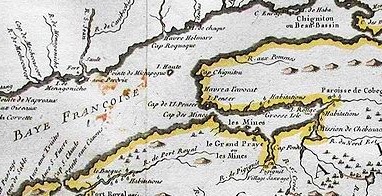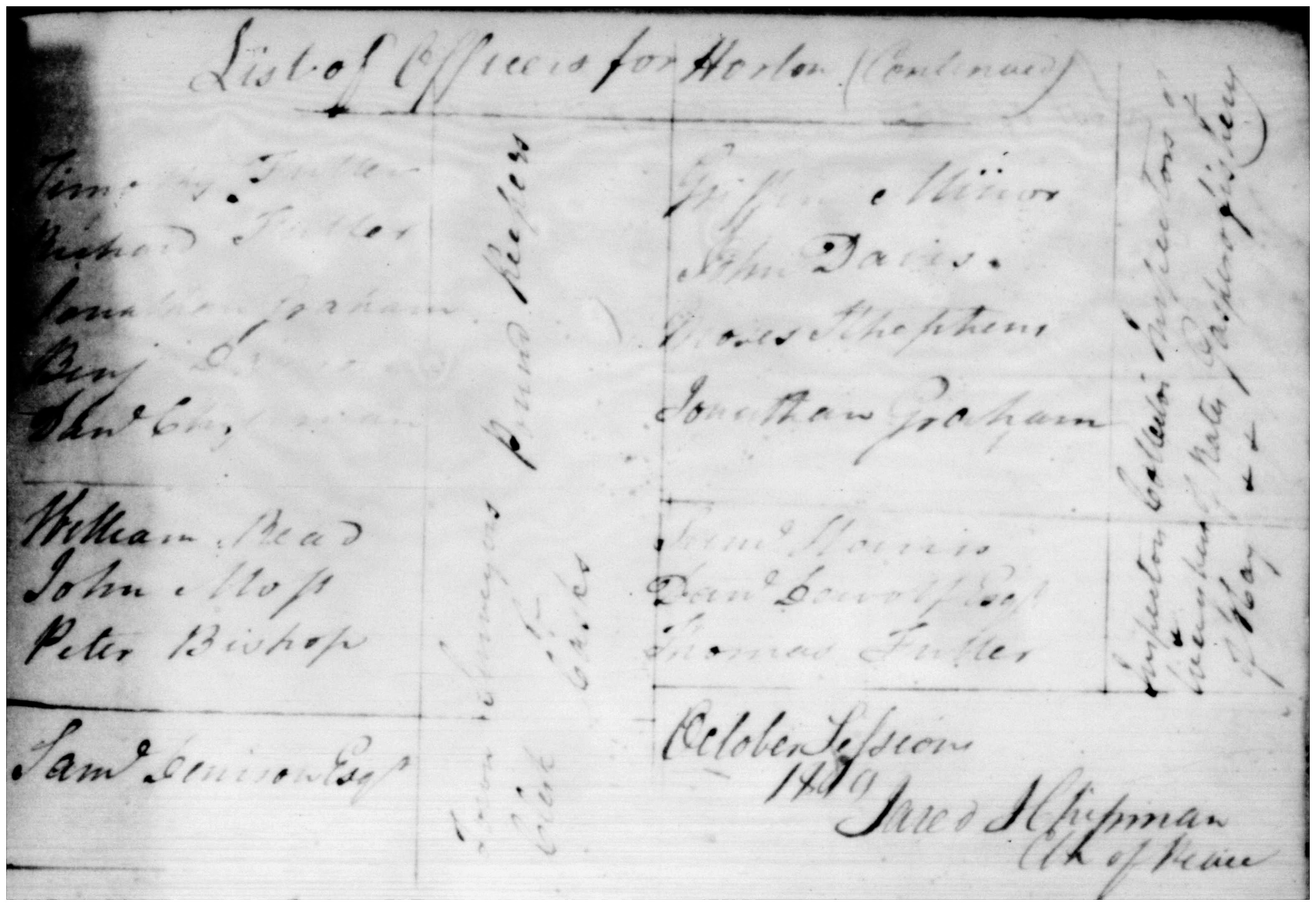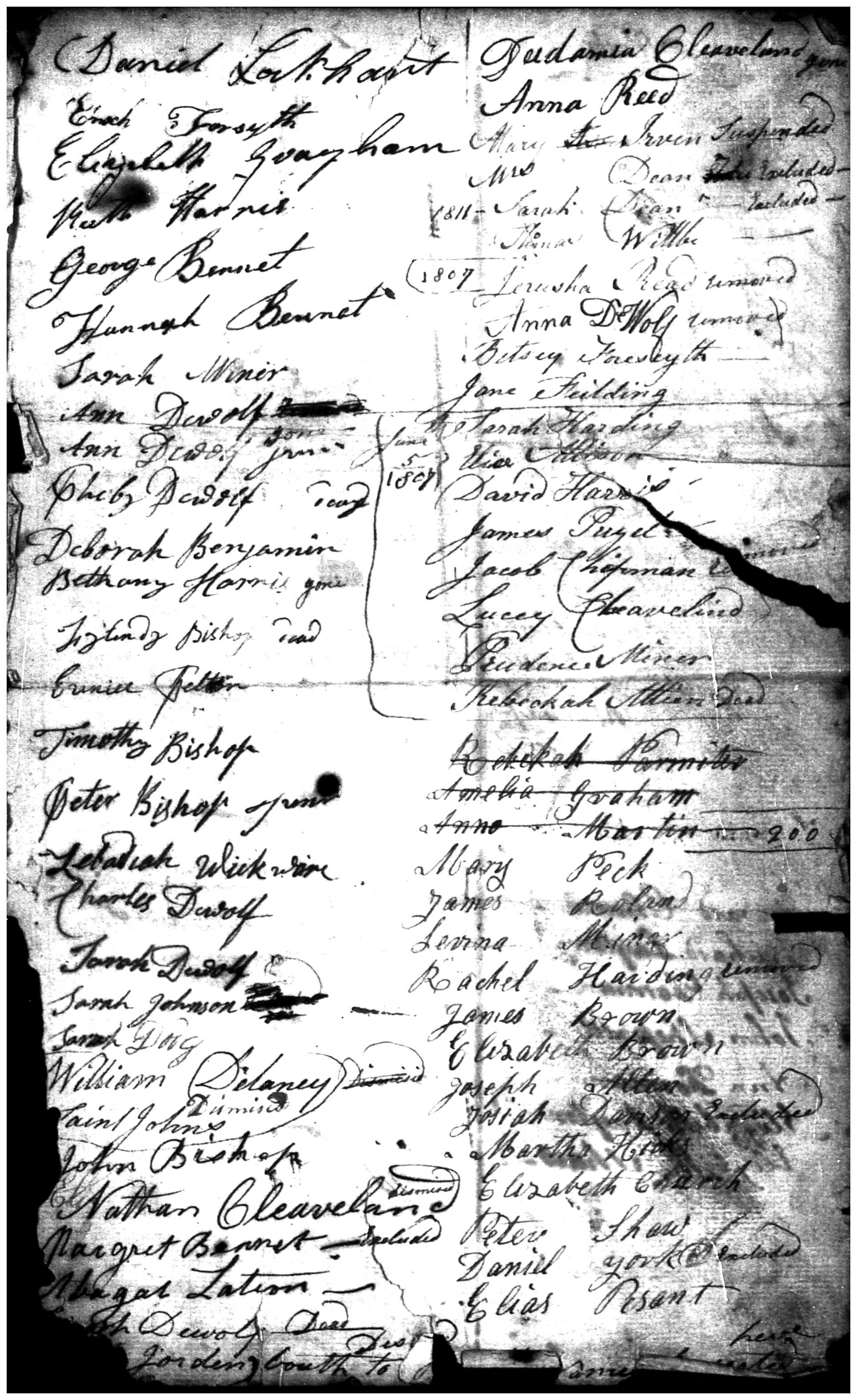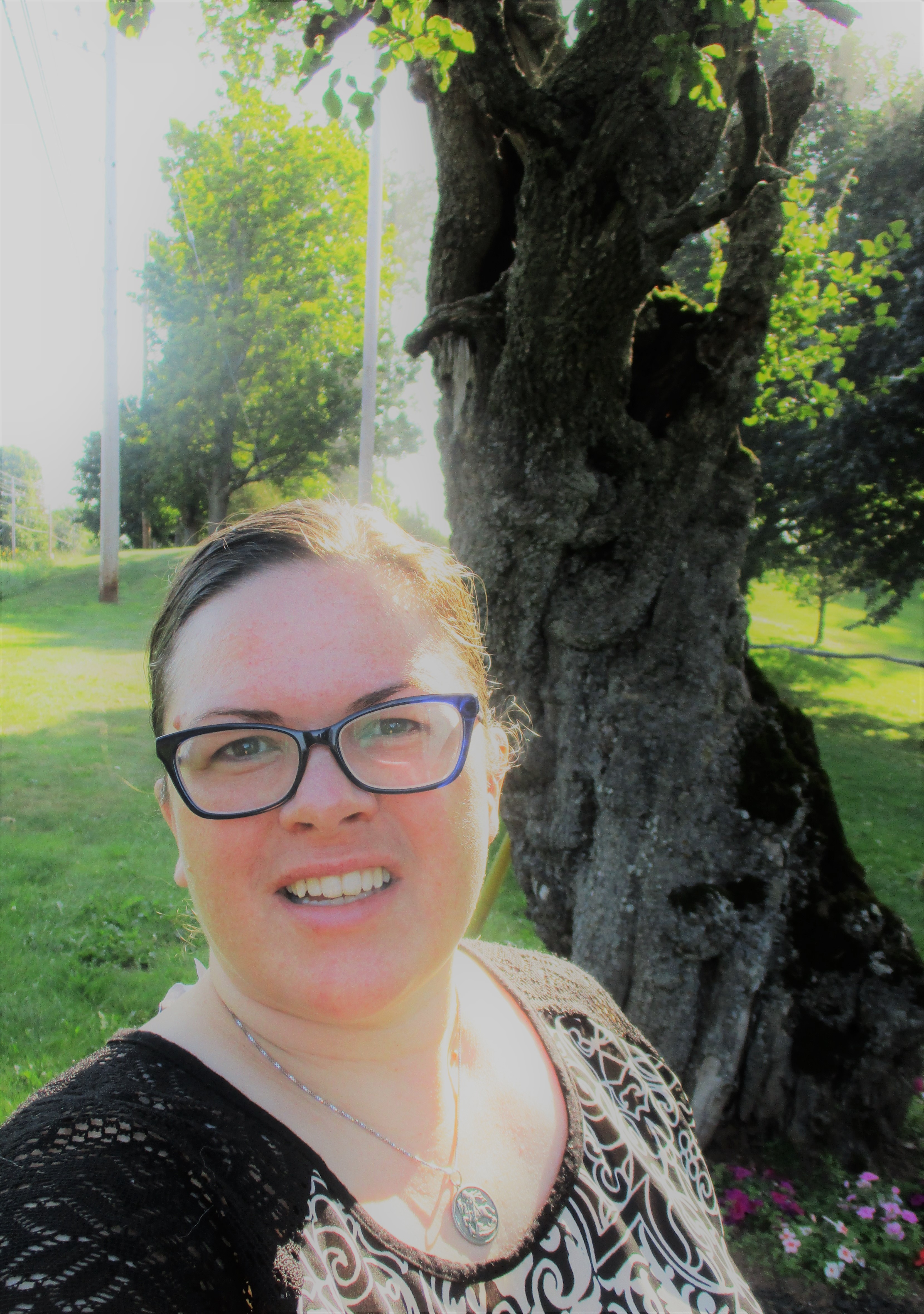- Submitted on
- 4 comments
First brought to Nova Scotia as a young shoot in 1786, the “Bishop Pear Tree” still stands—gnarled but solid—near the edge of the Ken-Wo Golf Club in New Minas, Nova Scotia. The young tree was carried from Connecticut by Peter Bishop Jr. returning with his new wife to Nova Scotia, two hundred and thirty-four years ago.

(Image Leah Grandy, UNB Libraries)
Peter Bishop Jr. (1763-1848) was the son of Connecticut Planter, Peter Bishop Senior (1735-1825), and had gone back to his father’s hometown of New London to get married. The elder Peter Bishop had been one of the original land grantees in Horton Township, settling in what is now New Minas, Nova Scotia. Peter Bishop Sr. had come with the New England Planter migration, which included his father, John Bishop Sr., and three brothers—John Jr., William, and Timothy—around 1760.

(Image public domain via Wikimedia)
The land on which Horton Township (and later New Minas) was located was part of the unceded territory of the Mi’kmaq People. It had been settled in the seventeenth century by French whose descendants were the Acadians, a distinct society and culture which greatly improved the farmland through creation of dykeland and planting orchards. The Acadian settlement at Grand Pré was known as “Le Mines” (after the copper mines at Cape d’Or), from which the name New Minas was derived. After the Expulsion of the Acadians in 1755, Nova Scotia Governor Charles Lawrence proposed a settlement scheme for the rich, newly vacated farmland. Britain exploited the ready resources of the Annapolis Valley through the recruitment of settlers under the auspices of the Lords Commissioners of Trade and Plantations, eventually called Planters (an Elizabethan word for colonists), from the New England colonies.
Planters came looking for more arable land, which had become a hard commodity to acquire in the New England colonies, particularly for families with a large number of sons. The town plot for Horton Township was planned for what is now Horton Landing, but Planter settlement focused along the Cornwallis River and at Mud Creek, which became Wolfville. Settlement of the area was based on consolidating farms and also kinship ties.

(Credit: Leah Grandy, UNB Libraries)
Other Planter settlements included Cornwallis (which neighboured Horton), Falmouth, Newport, Annapolis, Granville, Yarmouth, Barrington, Liverpool, Chester, New Dublin, Port Roseway (Shelburne), Truro, Onslow, Londonderry, Pictou, Cumberland, Amherst, Sackville, and Maugerville, the latter two settlements are now part of the province of New Brunswick.
One of Peter Bishop Sr.’s original land grants was likely the “Hamilton Place” in Grand Pré, which he traded with the Hamilton brothers for their grant between Greenwich and New Minas which was called “Sunnyside.” Transfer of land among the Planters was a very common practice, particularly during the early decades of settlement. He was a leader among Baptists in the region beginning in 1763 and played a key role in the establishment of the Baptist Church of Christ in Horton. Indeed, the original meeting house was built on property which he owned near the Old Cemetery in modern Wolfville. Peter Jr.’s mother was his second wife, Phebe Hamilton (1737-1831), of Grand Pré.

(Nova Scotia, Court of the General Quarter Sessions of the Peace, Kings County, Minutes 1781-1812, The Loyalist Collection, Originals Nova Scotia Archives)
Peter Bishop Jr. was born in Nova Scotia on February 6, 1763 and married Amy Bowles (b. c. 1771, New London, Connecticut, d. 1851, Horton Township Nova Scotia) in 1786. They brought two pear shoots back from Connecticut with them to Nova Scotia, one of which survived until the 1990s and the other still lives on what was the Old Post Road, now Nova Scotia’s Highway 1 or Commercial Street in New Minas. Peter Jr. and Amy were farmers in New Minas and had eight children together. Peter Jr. was also to become a Baptist deacon in New Minas, like his father, and died in 1842 or 1848.

(Image courtesy of the Wolfville Baptist Church (formerly called Wolfville United Baptist Church). Membership List (1807-1972): 1900.389/10-14. Maritime Baptist Historical Collection: 1778-1852, The Loyalist Collection. Original housed in the Esther Clark Wright Archives, Acadia University, Wolfville, Nova Scotia)
The Bishop Pear Tree no longer grows pears, but its long life is remarkable, possibly due to it being hardier than modern varieties of pear trees. The Bishops were part of Kings Agricultural Society which formed in 1789, and as farmers had a vested interest in improving the quality of produce in the region. A descendant of Peter Bishop, Avard Bishop, grafted some of the original pear tree into his orchard at Noggins Corner Farm, now owned by his son Andrew, which is in the area of the original Bishop farmlands. A gavel was made from some of the harvested wood when the tree was pruned in 2010 and it is used by the Bishop Family Association.
The Bishops were one of the early Planter families who built and kept an agricultural foothold in the Annapolis Valley. The pear tree stands as a tangible connection to the past, along with the many Planter descendants who still make their home in the land originally settled by their ancestors.

(Image: Leah Grandy, UNB Libraries)
Postscript: I found out after writing this post that my husband and son are descendants of the brother of Peter Bishop Sr., William Bishop. Interesting connections!
Thanks go out to the Church Historian of the Wolfville Baptist Church, Shirley Soleil-Day, for her help and expertise.
Leah Grandy holds a PhD in History and works as a Microforms Assistant at the Harriet Irving Library.
The Loyalist Collection- Selection Planter Primary Sources
Acadia University, Library. Maritime Baptist Historical Collection: 1778-1852. Planters were key to the early formation of the Baptist Church in the Maritime Provinces.
Henry Alline. Life and Journal. Hymns and Spiritual Songs: 1802 - 1806. An influential evangelist preacher and Planter in the Annapolis Valley starting in the time of the American Revolution.
Chipman Family. Collection: 1821-1825. The Chipmans were one of the most prominent Nova Scotia Planter families and were positioned in society to give a view of the functioning of the province.
Edward DeWolf. Ledgers: 1773-1788, 1794-1797, 1802. The business records kept by a merchant in Horton Landing take the form of two ledgers that list daily transactions for goods purchased, amounts charged, and payments made on account.
Nova Scotia, Court of General Quarter Sessions of the Peace (Kings County). Minutes : 1781 - 1812. County Court of the General Quarter Sessions dealt with petty crime and also socio-economic issues using the New England model of Justices of the Peace and Grand Juries. Many locals appear listed as “parish officers.” (See post “Parish Officers of New Brunswick: Timber to Turkey” for more information on parish officers.)
Nova Scotia, Registry of Deeds (Annapolis County). Deeds: 1763-1819. This record would cover land exchanges for the Planter period and beyond.
Nova Scotia, Township Records. Local Records: 1720-1896. The volumes contain birth, marriage and death records for each Township including: Chester, 1762-1830; Cornwallis, 1720-1885; Falmouth, 1747-1825; Granville, 1720-1881; Horton, 1751-1895; Newport, 1752-1858; Onslow, 1761-1896; and Truro, 1761-1851.
Other Primary Sources
Acadia University’s digital collection, Chipman’s Corner, holds many useful records, such as the Cornwallis Township Record Book. Online versions of “Planter Notes,” the regular newsletter produced by the Planter Studies Centre, can also be found on this site.
Census Returns, Assessment and Poll Tax Records from 1767-1838 in Nova Scotia are available on the Nova Scotia Archives website.
Nova Scotia Planters – Select Secondary Sources
Bishop Family Association, Tangled Roots: Descendants of John Bishop (1709-1785) of Horton, Nova Scotia, A New England Planter Family, Volume III, Wolfville, Nova Scotia: Friesen Printers, 1990.
Margaret Conrad, ed., They Planted Well: New England Planters in Maritime Canada, Acadiensis Press, 1988.
Margaret Conrad, ed., Planter Studies Committee: Planter Studies Conference, "Making Adjustments: Change and Continuity in Planter Nova Scotia, 1759-1800, " Acadiensis Press, 1991.
______________. "Intimate Relations: Family and Community in Planter Nova Scotia, 1759-1800,"Acadiensis Press, 1995.
Margaret Conrad and Barry Moody, Planter Studies Conference, Planter Links: Community and Culture in Colonial Nova Scotia, Acadiensis Press, 2001.
S.W. DeBlois, Historical sketch of the 1st Horton Baptist Church, Wolfville: for the period of one hundred years, from A.D. 1778 to A.D. 1878, Halifax, N.S. : Messenger Printing Office, 1879.
Julian Gwyn, Planter Nova Scotia, 1760-1815, Wolfville, N.S.: Kings-Hants Heritage Connection, Wolfville Historical Society, 2010.
T. Stephen Henderson and Wendy G. Robicheau, eds., The Nova Scotia Planters in the Atlantic World, 1759-1830 , Acadiensis Press, 2012.
James Stuart Martell, Pre-Loyalist Settlements Around Minas Basin a History of the Townships of Cornwallis, Horton, Falmouth, Newport, Windsor, Truro, Onslow, and Londonderry, 1755-1783, with a Survey of the French Period, Halifax: Dalhousie University, 1980.
Debra Anne McNabb, Land and Families in Horton Township, N.S., 1760-1830, Thesis, University of British Columbia, 1986.
Judith A. Norton, New England Planters in the Maritime Provinces of Canada, 1759-1800: Bibliography of Primary Sources, Toronto; Buffalo: University of Toronto Press in association with Planter Studies Centre, Acadia University, 1993.
Frances Willick, “This venerable N.S. pear tree is older than Canada — by 81 years,” CBC News, June 01, 2019.
Esther Clark Wright, Planters and Pioneers (Self Published, 1978).
Other posts from Atlantic Loyalist Connections which feature Planters:
Surprising Church Records Part 1: Not Just Baptisms and Burials

Comments Add comment
Bathsheba Spooner: A Revolutionary Murder Conspiracy
Awesome
Cultivar
Cultivar
Thanks for your comment and interest! I do not have an specific information on the genetics of the pear tree, but the CBC article from 2019 mentions, " Avard Bishop, a descendant of Peter Bishop, has taken grafts that are now growing in his family farm's pear orchard. Three shoots were also planted across the road from the surviving tree." I would assume he would be the best person to contact for information on the strain.
Add new comment Comments